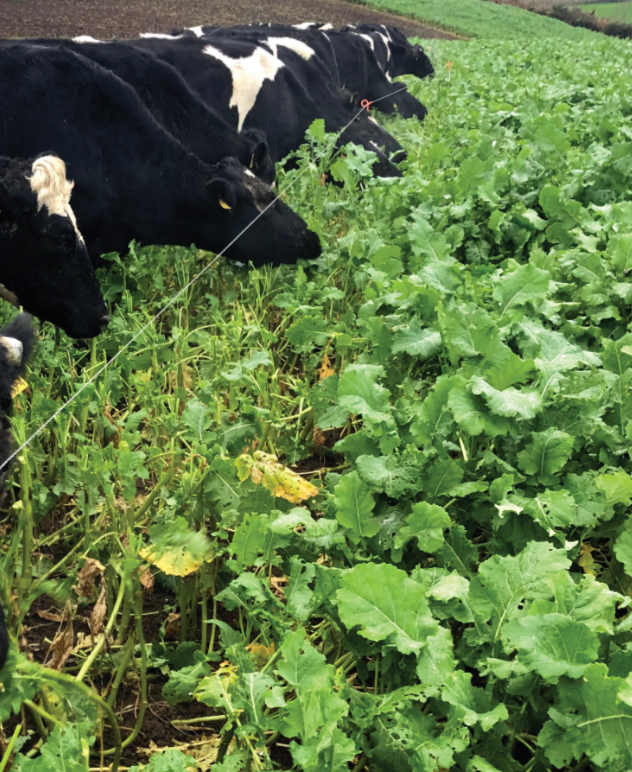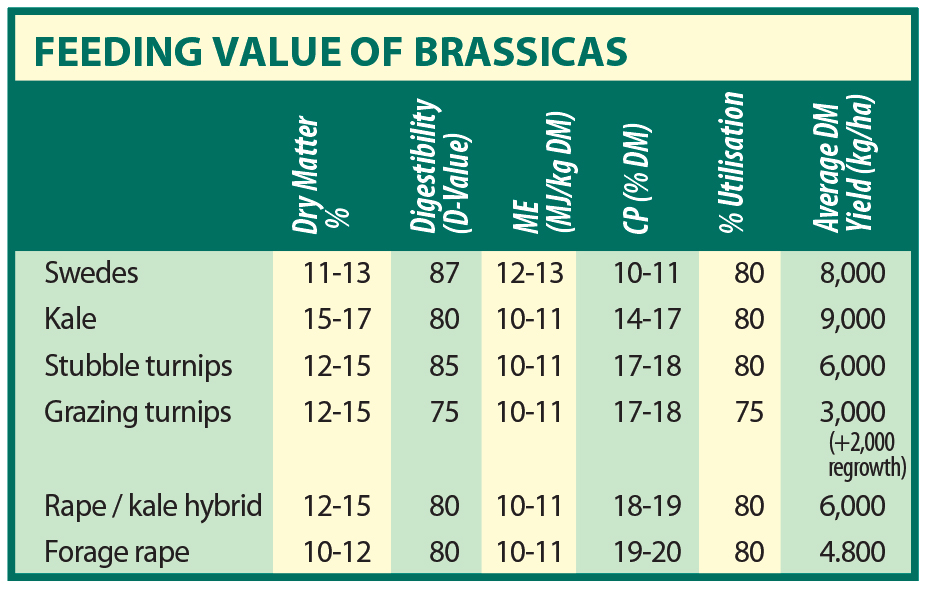 Brassica crops can provide a nutritious and cost effective feed source for cattle and sheep over the winter period. Crops such as Kale and Forage rape are capable of producing high dry matter (DM) yields which can then be fed in situ.
Brassica crops can provide a nutritious and cost effective feed source for cattle and sheep over the winter period. Crops such as Kale and Forage rape are capable of producing high dry matter (DM) yields which can then be fed in situ.
These high energy forage crops provide quality feed over winter and reduce the need for housing stock. Brassicas can be useful in both arable and grazing rotations. They are a good break or cover crop and can benefit soil structure. They allow time for split lime applications and effective weed control before reseeding.
Planning for brassica crops starts earlier in the year. Some thought should be given to the pitch of the field. If grazing a brassica crop on a slope, always graze from the top down so as to reduce soil runoff. Good agronomy and forward thinking at sowing will help during the feeding stage. Bales of silage should be placed in the field when sowing these brassica crops – these provide a vital source of fibre for stock when grazing. Brassicas are low in essential minerals – namely, iodine, selenium, copper and cobalt. Animals must be administered adequate minerals in the form of a lick or bolus.
Feeding Value of Brassicas
 The energy level of brassicas is on par with high quality silage but lower than that of cereals and concentrates. Crude protein content of leafy brassicas such as Kale is high at 14–20%, although it is much lower in root crops such as swedes. Brassicas have a high readily digestible carbohydrate content but are low in fibre, which is why they should be fed with a fibre source such as silage.
The energy level of brassicas is on par with high quality silage but lower than that of cereals and concentrates. Crude protein content of leafy brassicas such as Kale is high at 14–20%, although it is much lower in root crops such as swedes. Brassicas have a high readily digestible carbohydrate content but are low in fibre, which is why they should be fed with a fibre source such as silage.
Strip Grazing
The key to successful feeding with brassicas is to strip graze, using an electric fence to maximise crop utilisation. Each strip or ‘break’ should be long and narrow but allow all animals access to the crop at once. The fence should ideally be moved daily. Strip grazing small areas will provide the most efficient utilisation. Grazing larger areas will increase trampling and wastage. Introduce stock to the crop slowly on full stomachs to avoid digestive upsets. Ideally start by allowing the stock access to the crop for one to two hours a day, building up to unrestricted access after seven to ten days. It is strongly recommended that a run-back area is provided. This will increase utilisation and reduces the risk of contamination of hides and fleeces.
How do I calculate the size of the strip?

Measuring Dry Matter
For accurate feed planning it is essential to measure the Dry Matter (DM) yield of the crop. This can easily be done by using a:
- 1m square frame
- Large bag
- Pair of garden shears
- Scales
A number of samples should be taken from each field, picking representative sampling points.
1. Place frame in the forage crop
2. Use shears to cut each plant within the frame (about 10cm from the ground). Put the harvested crop in the bag
3. Hook bag onto scales and record the crop weight per metre squared (kg/m2
4. To calculate DM yield/ha multiply the fresh weight per m2 by 10,000, then multiply by the expected crop DM percentage.
(Take 16% for measurement, but always shake off excess water on the harvested sample)
For example: Kale from 1m2 = 5kg fresh weight x 10,000 = 50,000kg fresh weight/ha.
Average kale dry matter = 16% = 50,000 x 0.16 = 8,000kg (8t) DM/ha available.
Drummonds stocks a range of grass & forage seeds. If you have any queries please contact your local Drummonds Agronomist for further information.

